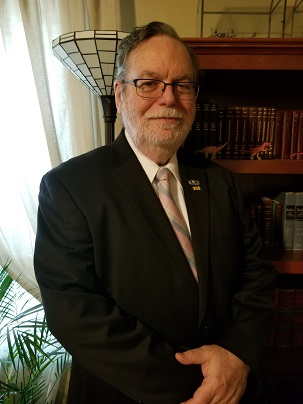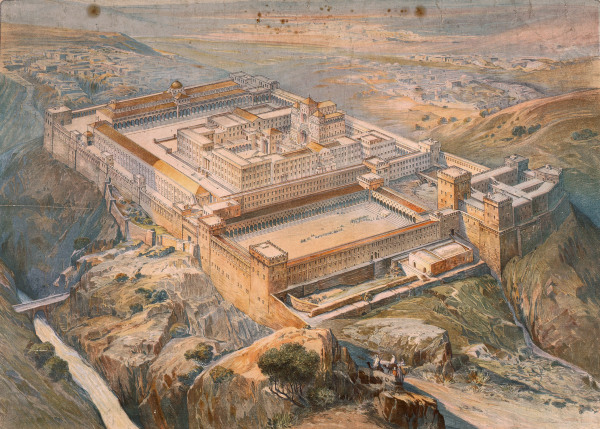
Stephen
Terry, Director


Jesus
Opens the Way Through the Veil
Commentary
for the March 5, 2022, Sabbath School Lesson
 "At that moment the curtain of the temple was torn in
two from top to bottom. The earth shook, the rocks split." Matthew 27:51, NIV
"At that moment the curtain of the temple was torn in
two from top to bottom. The earth shook, the rocks split." Matthew 27:51, NIV
From the time of Moses through the
reign of King David, God's presence among the Jews was represented by a tentlike
structure appropriate to nomadic architecture. God was the God of the wandering
in the wilderness. His ephemeral, shekinah essence was somehow condensed and shone
forth between two carved cherubim above an ark, or gold-plated, wooden box. The
temporary tabernacle that held this ark, was itself surrounded by a tent wall
that enclosed a large courtyard. In addition to enclosing the Tabernacle, it
also held an altar for burnt offerings and water for purification.
The Tabernacle was divided into
two rooms. The Holy of Holies was where the Ark and God's presence were to be
found. The other room contained the Altar of Incense, the Table of Shewbread,
and the Menorah or lampstand. A curtain separated the two rooms. While priests entered
the room with the Menorah daily, the holiest room was only entered once per
year on Yom Kippur, or the Day of Atonement.
The curtain represented the
inability of sinful man to come into the presence of God and live. The priest who
officiated for Yom Kippur wore bells on his garments so that those outside of
the Holy of Holies could hear them tinkling and take comfort in knowing that the
priest's sins had not brought about his death for presuming to come into the
presence of God without recognition of his sin and the required repentance.
Once Israel had conquered their
enemies and felt secure in the land promised to Abraham centuries before, King
David wanted to build a permanent structure for God's presence. But since he
was unable to do so during his reign, his son Solomon assumed the task and
completed the First or Solomon's Temple. However, a few centuries later, the
Babylonians demolished that Temple as well as the city of Jerusalem. The Bible
tells us this was because of the corruption and the faithlessness of the people
and their rulers. Any inhabitants of significance who survived the destruction were
carried off to exile in Babylon.
Three quarters of a century
later, after the Babylonians themselves were defeated by an alliance of Medes
and Persians, some Jews took that opportunity to
return to Jerusalem, hoping to rebuild the city and the Temple. The resulting structure
was the Second Temple. Since Zerubbabel was the leader of these intrepid recolonizers,
it was also known as Zerubbabel's Temple. That Temple stood for half a millennium.
Originally a humble structure, it was enhanced magnificently during the reign
of Herod the Great. So, it was also referred to as Herod's Temple. When the
Jews rose in revolt in 66 CE, the Temple and the city were once again destroyed,
this time by the Romans. The Temple has not been rebuilt since. Some Jews and Christians feel that a third temple must be constructed
before the Messiah will be revealed per the Jews or will return in the Parousia
per the Christians.
But the buildings, whether fabric
or marble, tabernacle or temple are of little significance. The metaphorical
drama acted out inside was where the meaning was to be found. When we see medieval
and even modern cathedrals, we are tempted to think the edifice is vital to the
metaphor. It is not. When the disciples marveled at the beauty of Herod's Temple,
Jesus revealed the folly of such an attitude and told them that the buildings were
destined for destruction. We want to associate that destruction with the razing
of the Temple in 70 CE by the Romans, but spiritually and metaphorically, the
destruction occurred decades before that. As our opening verse tells us, when
Christ died upon Golgotha, the curtain that separated the room that only the
high priest could enter each year from the one where the rest of the priesthood
ministered daily was "torn in two from top to bottom." While this incident was
cited in the Gospels, Christ's followers did not attribute any particular importance
to it prior to the Temple's destruction. We know this because they were still
offering sacrifices in the Temple years after Christ's ascension.[i] It
was while he was entering the Temple to make an offering that Paul was attacked
and arrested.
After the temple was destroyed,
both Jews and Christians struggled to understand how to move forward. For the
Jews it meant strengthening the synagogue system that had begun during the time
of the Maccabees, when the Temple was profaned, and sacrifices could not be
offered. The Holy of Holies in the Temple with the wooden Ark containing the
Decalogue is echoed with synagogues containing the Torah within its special
chamber behind the Beema. But in its own way, it was a fulfillment of the
tearing of the curtain, for now every member of the synagogue came symbolically
together into the presence of God through the Torah, or the Word of God.
Christians came to a similar
understanding once they saw the significance of the rending of the curtain.
When that realization dawned, we do not know, but since most scholars feel the
three synoptic Gospels that mention it were all written after the destruction
of the Temple, it is likely early Christians, like the Jews, came to understand
the event's importance after the fact, especially since Acts places them still
in the precincts of the Temple after Christ's ascension, where sacrifices still
continued as before.
Perhaps it was the idea of the
veneration of a building that played a part in Paul's attempts to fellowship
with Jews and Gentile converts to Judaism in the synagogues when he traveled. The
fact that he was often expelled from those synagogues may have been God telling
him to give up that idea, just like he sent a prophet to Paul to warn him not
to go to Jerusalem.[ii]
But Paul chose to ignore it, went to the Temple in Jerusalem, and was arrested.
Unfortunately, we do not know what might have happened if Paul had either listened
to the prophet Agabus or if he had understood that sacrifices were no longer
necessary.
While the sacrifices offered at
the Temple were ongoing, they had no ability to cleanse us from sin.[iii]
That they were continually offered was evidence that sin also continued despite
the sacrifices. Our desire to construct expensive edifices and teach one
another that the continual sacrifice of our time and resources to maintain both
building and order of services is little more than a paean to the idea that the
Temple and its services should continue on the earth. Depending on the dogma of
our faith's manifestation of that practice, we may recite approved, formulaic
public prayers, congregational responses, or stylized genuflections. We may jump
about shouting that we are filled with the Holy Spirit, babbling in unknown
tongues. We may pay someone to stand in the pulpit and remind us each week of
our need for dogmatic purity. That none of these activities typically happens
on the public streets despite freedom of worship illustrates that it is about the
building and therefore is more of the earthly temple than the heavenly. As such
worshipers, Christians are little different than the Jews in their synagogues
with their Torah scrolls.
Christ died to set us free, but
we prefer those rites and rituals that could never set us free before Christ
and certainly cannot do so now. We choose to willingly place our bodies in bondage
to judgment we pass on ourselves and others and that they also pass on us.
There is no freedom in that. Freedom is in knowing that we can each approach
God directly on our own. The curtain has been torn in two. There is no longer a
barrier. We do not have to be free of sin to come before God. That is what
Christ's sacrifice was for, to remove our condemnation.[iv]
He provided the way through the veil, no bells attached. Despite the entre to
salvation that grace provides, we still try to gain entrance through ritualized
attempts at perfection.
Sadly, because of such efforts,
too many turn away frustrated at their inability to be as prefect as they or
others think they should be. But it is not God's will that it should be like that.
He turns no one away who comes to him, whether they come to him openly like his
disciples or secretly like Nicodemus. As Jesus said, "Whoever comes to me I
will never drive away." (John 6:37) We can know that Jesus has given us freedom
to be what we were meant to be when we see ourselves becoming more
compassionate, empathetic, loving, and kind, not only to our friends but to
everyone, and not to earn "brownie points" with God, but because we see
ourselves in them and treat them as we wish others had treated us. Through grace,
we have a chance to treat others better than he was treated, or better than we
have been treated. That is what it is all about. That is why buildings have
nothing to do with it.